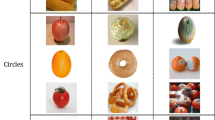Abstract
A variety of cognitive mechanisms have been proposed to apprehend the maintenance of delusional beliefs, a typical feature of schizophrenia. However, none of these mechanisms takes into account the verbal properties of delusions. An alternative behavioral approach is proposed, which considers delusional beliefs as verbal rules and maintenance of delusions as a form of rule-based insensitivity to changing environmental contingencies. A pilot study is described in which patients formerly presenting with delusional ideas and control participants were exposed in a repeated measures design to three different instructional conditions, instructions, no instructions, and self-instructions, in the context of a non-signaled changing multiple reinforcement schedule. Results suggest that, in the presence of instructions, patients formerly presenting with delusional ideas demonstrate greater insensitivity to changes in schedule contingencies than control participants. While these findings are preliminary, they suggest that rule-based insensitivity to changing environmental contingencies constitutes a new promising way to approach maintenance of delusional beliefs.
Similar content being viewed by others
Notes
Accepted by CCPPRB of Picardie under reference 03H19.
Fixed reinforcement schedules have been preferred to variable ones so that adjusted patterns of response are distinguished clearly across the two keys of responses, and lack of adjustment is easily observed during the reversed part of the experiment.
Keeping the data from the first presentation of each schedule in the data set revealed that patients in SI groups did not adjust to contingencies changes in regular phase, as controls WI and patients NI groups did not. In sum, the changes comparing the results without the first presentation of the results are from adjustment to non-adjustment to the programmed contingencies. Presentation of each schedule engenders too eratic behaviors since participants spend this first presentation exploring the contingencies.
Interestingly, the difference of adjustment between Patients and Controls WI groups in the reversed phase of the experiment while keeping the first presentation data shows that controls tend to be maladjusted during first presentation, then to adapt to contingencies (they carry on following the instruction at first presentation, then adjusted their behaviors), while patients fail to do so.
As it turned out, the instructions formulated by control participants and patients corresponded closely in all but one case to those actually given to the participants in the with-instruction groups. Only one patient formulated slightly different instructions and, even in this case, these instructions, when followed, engendered similar patterns of response This participant thought that in the ratio program, he had to press strongly among a sequence of light presses, while in the interval program, three presses followed by a pause were needed to earn a point. Following these instructions, he would have emitted more responses on the ratio program, exactly as with a more accurate instruction.
References
Bach, P., & Hayes, S. C. (2002). The use of Acceptance and Commitment Therapy to prevent the rehospitalization of psychotic patients: A randomized controlled trial. Journal of Consulting and Clinical Psychology, 70, 1129–1139.
Bach, P., Gaudiano, B. A., Hayes, S. C., Herbert, J. D. (2012). Acceptance and commitment therapy for psychosis: intent to treat, hospitalization outcome and mediation by believability. Psychosis, 1-9. doi:10.1080/17522439.2012.671349
Baron, A., & Galizio, M. (1983). Instructional control of human operant behavior. The Psychological Record, 33, 495–520.
Bentall, R. P. (1994). Cognitive biases and abnormal beliefs: towards a model of persecutory delusions. In A. S. David & J. Cutting (Eds.), The Neuropsychology of Schizophrenia (pp. 337–360). Hove: Lawrence Erlbaum Associates.
Catania, A. C. (1991). Glossary. In I. H. Iversen & K. A. Lattal (Eds.), Experimental analysis of behavior. Part 2 (pp. G1–G44). Amsterdam: Elsevier.
Catania, A. C., Shimoff, E., & Matthews, B. A. (1989). An experimental analysis of rule-governed behavior. In S. C. Hayes (Ed.), Rule-governed behavior. Cognition, contingencies, and instructional control (pp. 119–150). New-York: Plenum Press.
Catania, A. C., Shimoff, E. H., & Matthews, B. A. (1990). Properties of rule-governed behaviour and their implications. In D. E. Blackman & H. Lejeune (Eds.), Behaviour analysis in theory and practice (pp. 215–230). Hove & London: Erlbaum.
Corcoran, R., Cahill, C., & Frith, C. D. (1997). The appreciation of visual jokes in people with schizophrenia: A study of 'mentalizing' ability. Schizophrenia Research, 24, 319–327.
Corcoran, R., Mercer, G., & Frith, C. D. (1995). Schizophrenia, symptomatology and social inference: investigating "theory of mind" in people with schizophrenia. Schizophrenia Research, 17, 5–13.
Doody, G. A., Gotz, M., Johnstone, E. C., Frith, C. D., & Owens, D. G. (1998). Theory of mind and psychoses. Psychological Medicine, 28, 397–405.
Dudley, R. E. J., John, C. H., Young, A. W., & Over, D. E. (1997). Normal and abnormal reasoning in people with delusions. British Journal of Clinical Psychology, 36, 243–258.
Ferster, C. B., & Skinner, B. F. (1957). Schedules of reinforcement. New York: Appleton-Century-Crofts.
Freeman, D., Garety, P. A., & Kuipers, E. (2001). Persecutory delusions: developing the understanding of belief maintenance and emotional distress. Psychological Medicine, 31, 1293–1306.
Freeman, D., Garety, P. A., Kuipers, E., Fowler, D., & Bebbington, P. E. (2002). A cognitive model of persecutory delusions. British Journal of Clinical Psychology, 41, 331–347.
Freeman, D., Garety, P. A., Kuipers, E., Fowler, D., Bebbington, P. E., & Dunn, G. (2007). Acting on persecutory delusions: the importance of safety seeking. Behaviour Research and Therapy, 45, 89–99.
Frith, C. D., & Corcoran, R. (1996). Exploring 'theory of mind' in people with schizophrenia. Psychological Medicine, 26, 521–530.
Gaudiano, B. A., & Herbert, J. D. (2006). Acute treatment of inpatients with psychotic symptoms using Acceptance and Commitment Therapy: Pilot results. Behaviour Research and Therapy, 44, 415–437.
Garety, P. A., & Freeman, D. (1999). Cognitive approaches to delusions: a critical review of theories and evidence. British Journal of Clinical Psychology, 38, 113–154.
Garety, P. A., Hemsley, D. R., & Wessely, S. (1991). Reasoning in deluded schizophrenic and paranoid patients: biases in performance on a probabilistic inference task. Journal of Nervous and Mental Disease, 179, 194–201.
Hayes, S. C., Brownstein, A. J., Zettle, R. D., Rosenfarb, I. S., & Korn, Z. (1986). Rule-governed behavior and sensitivity to changing consequences of responding. Journal of the Experimental Analysis of Behavior, 45, 237–256.
Hayes, S. C., Strosahl, K., & Wilson, K. G. (1999). Acceptance and Commitment Therapy: An experiential approach to behavior change. New York: Guilford Press.
Hemsley, D. R., & Garety, P. A. (1986). Formation and maintenance of delusions: a Bayesian analysis. British Journal of Psychiatry, 149, 51–56.
Huq, S. F., Garety, P. A., & Hemsley, D. R. (1988). Probabilistic judgements in deluded and non-deluded subjects. Quarterly Journal of Experimental Psychology, 40, 801–812.
Kaney, S., & Bentall, R. P. (1989). Persecutory delusions and attributional style. British Journal of Medical Psychology, 62, 191–198.
Kinderman, P., & Bentall, R. P. (1996). Self-discrepancies and persecutory delusions: evidence for a model of paranoid ideation. Journal of Abnormal Psychology, 105, 106–113.
Kinderman, P., & Bentall, R. P. (1997). Causal attributions in paranoia and depression: internal, personal, and situational attributions for negative events. Journal of Abnormal Psychology, 106, 341–345.
Kinderman, P., & Bentall, R. P. (2000). Self-discrepancies and causal attributions: studies of hypothesized relationships. British Journal of Clinical Psychology, 39, 255–273.
Lee, J., & Park, S. (2005). Working memory impairments in schizophrenia: a meta-analysis. Journal of Abnormal Psychology, 114(4), 599–611. doi:10.1037/0021-843X.114.4.599.
Lyon, H. M., Kaney, S., & Bentall, R. P. (1994). The defensive function of persecutory delusions: evidence from attribution tasks. British Journal of Psychiatry, 164, 637–646.
Maher, B. A. (1974). Delusional thinking and perceptual disorder. Journal of Individual Psychology, 30, 98–113.
Maher, B. A. (1988). Anomalous experience and delusional thinking: The logic of explanations. In T. F. Oltmanns & B. A. Maher (Eds.), Delusional Beliefs (pp. 15–33). New York: Wiley.
Maher, B. A. (1999). Anomalous experience in everyday life: its significance for psychopathology. The Monist, 82, 547–570.
Moritz, S., & Woodward, T. S. (2006). A generalized bias against disconfirmatory evidence in schizophrenia. Psychiatry Research, 142, 157–165.
Rosenfarb, I. S., Newland, M. C., Brannon, S. E., & Howey, D. S. (1992). Effects of self-generated rules on the development of schedule-controlled behavior. Journal of the Experimental Analysis of Behavior, 58, 107–121.
Sarfati, Y. (2000). Deficit of the theory-of-mind in schizophrenia: clinical concept and review of experimental arguments. Canadian Journal of Psychiatry, 45, 363–368.
Sharp, H. M., Fear, C. F., & Healy, D. (1997). Attributional style and delusions: an investigation based on delusional content. European Psychiatry, 12, 1–7.
Shimoff, E., & Catania, A. C. (1998). The verbal governance of behavior. In K. A. Lattal, M. Perone, & I. H. Iversen (Eds.), Handbook of human operant behavioral research methods. New York: Plenum Press.
Startup, H., Freeman, D., & Garety, P. A. (2007). Persecutory delusions and catastrophic worry in psychosis: developing the understanding of delusion distress and persistence. Behaviour Research and Therapy, 45, 523–527.
Torneke, N., Luciano, C., & Valdivia Salas, S. (2008). Rule-Governed Behavior and Psychological Problems. International Journal of Psychology and Psychological Therapy, 8, 141–156.
Vaughan, M. (1989). Rule-governed behavior in behavior analysis. A theoretical and experimental history. In S. C. Hayes (Ed.), Rule-governed behavior. Cognition, contingencies, and instructional control (pp. 97–118). New-York: Plenum Press.
Woodward, T. S., Moritz, S., & Chen, E. Y. H. (2006a). The contribution of a cognitive bias against disconfirmatory evidence (BADE) to delusions: a study in an Asian sample with first episode schizophrenia spectrum disorders. Schizophrenia Research, 83, 297–298.
Woodward, T. S., Moritz, S., Cuttler, C. C., & Whitman, J. (2004). A generalized cognitive deficit in integrating disconfirmatory evidence underlies delusion maintenance in schizophrenia. Schizophrenia Research, 67, 79.
Woodward, T. S., Moritz, S., Cuttler, C. C., & Whitman, J. (2006b). The Contribution of a Cognitive Bias Against Disconfirmatory Evidence (BADE) to Delusions in Schizophrenia. Journal of Clinical and Experimental Neuropsychology, 28, 605–617.
Wulfert, E., Greenway, D. E., Farkas, P., Hayes, S. C., & Dougher, M. J. (1994). Correlation between self-reported rigidity and rule-governed insensitivity to operant contingencies. Journal of Applied Behavior Analysis, 27, 659–671.
Yogev, H., Hadar, U., Gutman, Y., & Sirota, P. (2003). Perseveration and over-switching in schizophrenia. Schizophrenia Research, 61(2–3), 315–321.
Zettle, R. D., & Hayes, S. C. (1982). Rule governed behavior: A potential theoretical framework for cognitive behavior therapy. In P. C. Kendall (Ed.), Advances in cognitive behavioral research and therapy (pp. 73–118). New York: Academic Press.
Author information
Authors and Affiliations
Corresponding author
Rights and permissions
About this article
Cite this article
Monestès, J.L., Villatte, M., Stewart, I. et al. Rule-Based Insensitivity and Delusion Maintenance in Schizophrenia. Psychol Rec 64, 329–338 (2014). https://doi.org/10.1007/s40732-014-0029-8
Published:
Issue Date:
DOI: https://doi.org/10.1007/s40732-014-0029-8




